| Vintage Pulp | Dec 17 2022 |

Some people shouldn't be allowed behind the wheel. Others shouldn't be allowed behind the typewriter.

We always try to highlight nice art, but Duane Rimel's 1961 novel Carnal Psycho, with its cheap cover work, was an add-on to a group of other books we acquired. It went unread for a while, until a few days ago when we decided to take a shot in the dark. Set in a place called Layton, Idaho, the main character Mark Jason accidentally runs over a woman on a misty highway, killing her. A month later Jason is himself hit and injured by a car, and the driver escapes. That's all backstory.
As the book opens Jason is receiving threatening calls, with the voice on the other end promising to kill him, or failing that, kill his friends. And indeed, people around him are slain. One is run down by an automobile, and sabotage to Jason's car causes another death. All that makes the “carnal” of the title a pun, we suppose, since sex is not the focus of the book. Anyway, Jason puts on his amateur sleuth pants to try and solve the mystery of who wants to kill him.
The main issue with Carnal Psycho is that it isn't well written. There are a few interesting moments, and a few notable turns of phrase, such as when the killer is described as, “this sly loosener of bolts, this driver of cars, this deadly amanita,” but overall the book is inconsequential and unrecommendable. We haven't read Rimel's previous effort Carnal Orgy, but we can't help wondering if it's about cars too. We'll never find out, because we're never going to ride with him again. That's a guarantee.
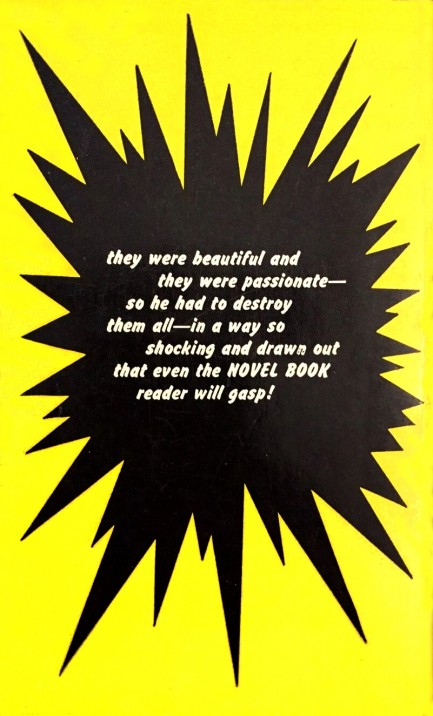
| Intl. Notebook | Sex Files | Oct 27 2021 |

It's not how you start. It's how you finish.
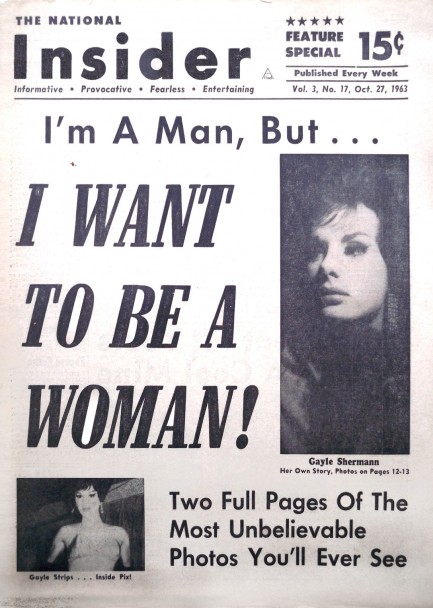
We've talked before about the mid-century tabloid interest in transexuals, and how several trans burlesque performers achieved widespread fame. Those old tabloid covers serve to contradict people who claim that trans issues are a product of the new millennium, or that “it didn't happen in their day.” They just didn't notice. As the links in the above post show, transexual entertainers regularly made headlines in tabloids that sold millions of issues per month. To the list you can now add Gayle Sherman, who you see on this cover of The National Insider published today in 1963. This wasn't the height of her fame. A year later Novel Books would publish I Want To Be a Woman!, touted as the autobiography of a female impersonator. And still, she was just getting started.
Sherman started life as Gary Paradis, but became Sherman after a name change at age sixteen. As a transvestite she scored a job dancing for the Jewel Box Revue, which was a comedic drag queen show that criss-crossed the U.S. for more than thirty years. Probably the Jewel Box Revue  deserves a write-up of its own, but the shorter version is it was the most popular extravaganza of its kind, and was run by gay management who were marketing to straight audiences.
deserves a write-up of its own, but the shorter version is it was the most popular extravaganza of its kind, and was run by gay management who were marketing to straight audiences.
 deserves a write-up of its own, but the shorter version is it was the most popular extravaganza of its kind, and was run by gay management who were marketing to straight audiences.
deserves a write-up of its own, but the shorter version is it was the most popular extravaganza of its kind, and was run by gay management who were marketing to straight audiences.Sherman moved on from the revue and worked mainly in Chicago, appearing at places such as the Nite Life, where her act sometimes involved dressing as a witch doctor and roasting a fake baby over a fire while singing Yma Sumac songs. Sometime later she underwent gender reassignment surgery, and all the while was passing through a string of pseudonyms, among them Gerri Weise, Brandy Alexander, and Geraldine Parades.
She eventually opted for breast enlargement surgery and at that point became Alexandria the Great 48, a stage name under which she would become a national celebrity. The number of course referenced her bust size. She was sometimes dubbed “Sophia Loren's twin,” but when audiences paid to see her they got something wholly different. She had left burlesque and moved into standard stripping, sometimes appearing at porno cinemas between features. She continued dancing until 1967, when bluenose politicians in Chicago managed to outlaw nude dancing. Sherman became a hairdresser, and was out of the public eye until her death in 2019.
As we mentioned above, vintage tabloids often featured transexuals, and while those stories were always sensationalistic, they were also surprisingly non-cruel. Not always, but often. The editors' accepting stances probably weren't sincere. Because tabloid readership was generally a cross section of middle class, middle American squares, the tone of the articles tended be: “this wild stuff happens in Hollywood and Paris, but who knows, maybe it's more prevalent than you suspect where you live.” As the saying goes, even a stopped clock is right twice a day—the tabs probably nailed it. 1.4 million Americans identify as transexual. There's no total from 1963, but you can bet it would be more than a few. In National Informer, the excellent money quote from the Gayle Sherman article is: “My birth certificate is stamped male, but my body is stamped female.” We have a photo of her below, and she's all woman.
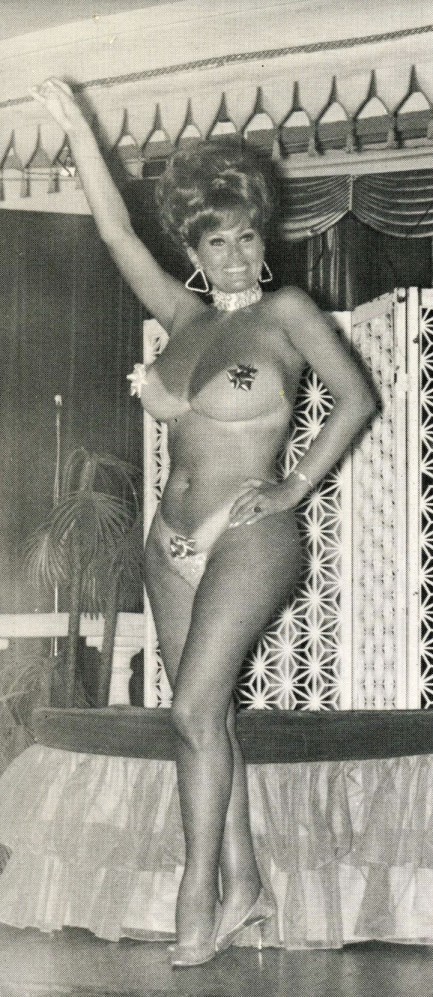
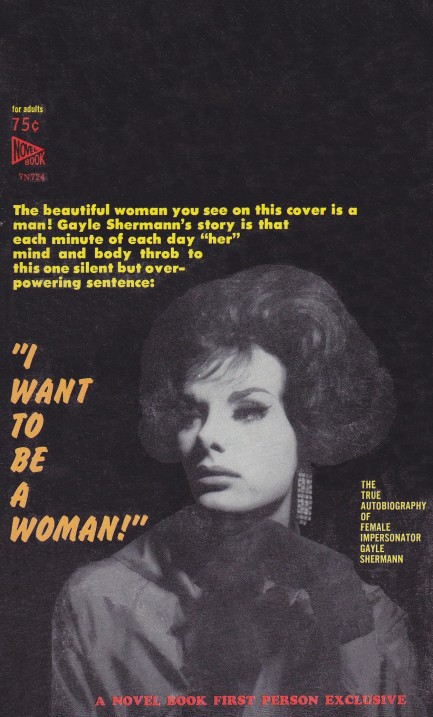


| Vintage Pulp | Apr 2 2020 |

Anything that other Betty does can do I can do better.
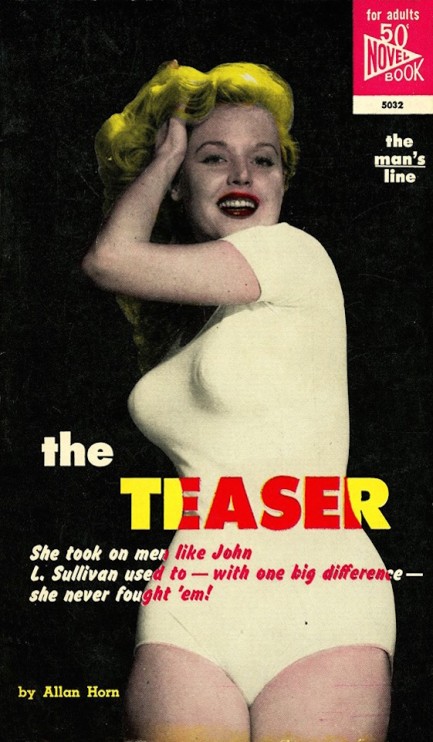
Bettie Page wasn't the only mid-century celebrity who made uncredited appearances on book covers. This front for Allan Horn's The Teaser features Betty Brosmer, she of the extreme hourglass figure with its famed eighteen inch waist. This cover appeared at the height of her modeling career, and since Novel Books wasn't a major imprint, we wonder if they paid for her image. We doubt it. The narrative here deals with a young woman who marries a seventy-year-old millionaire, and this is not the first time Horn explored this idea. He used it as the premise for 1966's, The Beast in the Bedroom. He's suspected of being a pseudonym. If so he wrote for several companies—Midwood, Vega/Tropic, Private Editions, and Playtime. That's getting around. We'll keep on the alert for more info on Mr. Horn. Maybe we'll even read one of his books. We saw Whore from Maupin Street cheap, and who can resist a title like that?




































































